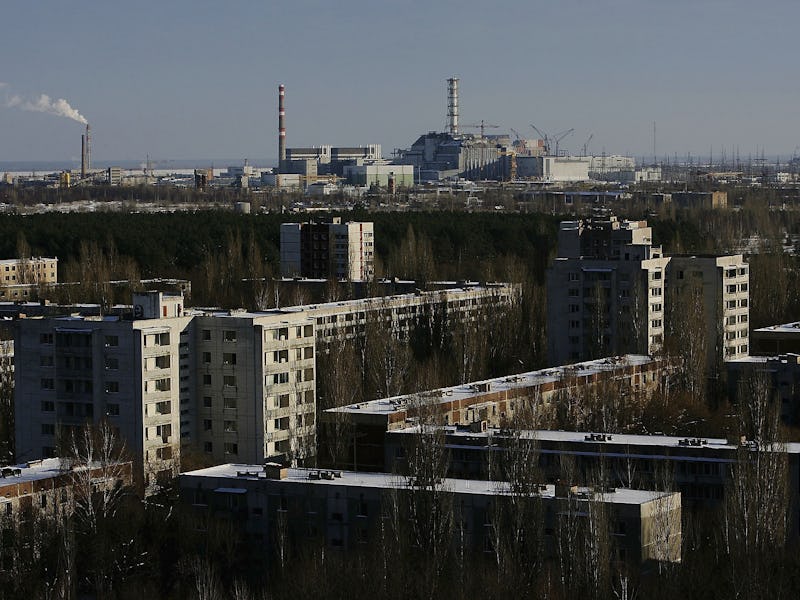Is Chernobyl Safe? It Depends How You Define "Safe"
Thirty years later, the question still persists.

On April 26, 1986, a fire from a test at the nuclear power plant in Chernobyl resulted in one of the worst nuclear meltdowns in history. To this day, the very name of the disaster site evokes thoughts of destruction. And on the 30th anniversary of the meltdown, the current — and future — safety of the location is still unclear.
What happened at Chernobyl?
Chernobyl is located in northern Ukraine. It was a part of the Soviet Union at the time of the meltdown, and, per the first New York Times article on the incident on April 29, 1986, the “severity of the accident, which spread discernible radioactive material over Scandinavia, was not immediately clear.”
Details slowly came out of the Soviet Union. The accident happened during a test to see how the nuclear plant would handle losing power. Operators made mistakes during test preparation. The test escalated into a full-on disaster.
One of the cooling plants in reactor number 3 in Chernobyl.
The test was done to simulate what would happen if the plant lost power. Operators turned off the systems that cooled the water running through the No. 4 reactor at the plant. Water that was sitting in the reactor started to boil, and steam started to drift off the surface. Attempts to cool the water failed. The steam, according to the Times, likely initiated an explosion that had a domino effect.
Radioactive smoke rose to the atmosphere and created a cloud over Europe and the western Soviet Union. Estimates put the radioactivity levels around 400 times that of the atomic bomb dropped on Hiroshima. Direct deaths from the explosion range from 31 to 56, but thousands of people got cancer from direct and indirect radiation exposure.
A sign warns of radiation near the "red forest" near Chernobyl.
How do we define “safe” in Chernobyl’s case?
The threat of radiation is still a problem at Chernobyl, although levels have decreased significantly enough that the Ukrainian government allows visitors if they are with a tour guide.
Chernobyl Tour, a company that bills itself as an “eye-opening experience of post-Apocalyptic world,” is one of the tour companies allowed in the 18.6-mile Chernobyl exclusion zone. Radiation clean-up and the passing of time have made some of the area in the delineated radiation zone safe for brief trips — as long as visitors follow the guidelines laid out by tour companies.
Prohibited tourist attire, according to Chernobyl Tour, includes: shorts, short trousers, skirts, open footwear, and short sleeves. Prohibited behavior includes: eating, drinking and smoking in open air; touching buildings, trees, plants; gathering and eating mushrooms, berries, fruit, and nuts in forests and gardens of the abandoned settlements, sitting on the ground, putting photo and video cameras, bags, backpacks and other personal belongings on the ground.
Of course, these rules are in place to help protect visitors who remain in the exclusion zone. Areas nearer to the reactor are still very dangerous, regardless of what shoes you’re wearing.
According to PBS, 10 minutes next to the No. 4 reactor gives someone close to seven times more than a fatal dose of radiation.
Yet in the “safe” zones of Chernobyl — the locations people are allowed to tour — Chernobyl Tour claims the radiation dose during a 10-hour tour is less than the dose a person gets on a transatlantic flight.
Most of the land around Chernobyl is deserted, but some people remain.
How close do people live near the Chernobyl nuclear site?
Despite the disaster and threat of radiation, people still work in the exclusion zone. The closest village, Sukachi, is around 25 miles from the No. 4 reactor.
According to the Daily Mail, around 3,000 people live in the exclusion zone for 14-day stints. Another 3,800 who work in the zone live on the borders and commute.
Michael Rothbart, the photojournalist behind the Chernobyl book called Would You Stay?, estimates that of the 2,000 geriatric villagers who illegally returned to the exclusion zone, around 400 are there today.
Artur Vlasenko, 27, getting screened for radiation. Vlasenko applied to work on Chernobyl.
Will Chernobyl ever be completely safe?
Estimates of when Chernobyl will once again be safe are as far away as 20,000 years, the Daily Mail reports. Yet reports from the Chernobyl Exclusion Zone claim that animals have come back to the land. They have extremely high levels of radiation, but they have come back.
A stray dog named Ivanich walks in front of reactor No. 4 in 2015.
Long-term effects of more mild forms of radiation are unclear. And therefore, the question of when Chernobyl will be truly safe for habitation continues to go unanswered. The United Nations Scientific Committee on the Effects of Atomic Radiation, however, seems hopeful.
“Lives have been seriously disrupted by the Chernobyl accident,” UNSCEAR writes, “but from the radiological point of view, generally positive prospects for the future health of most individuals should prevail.”